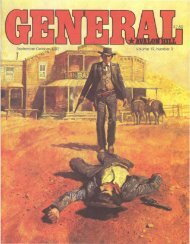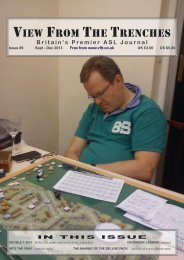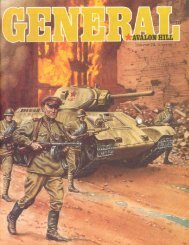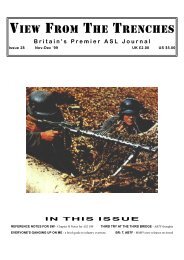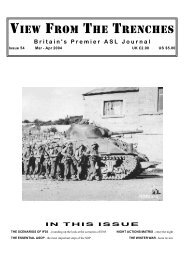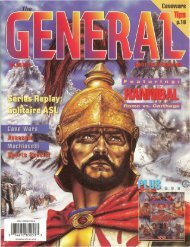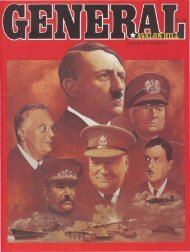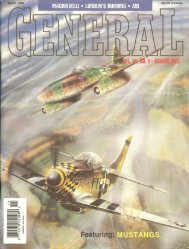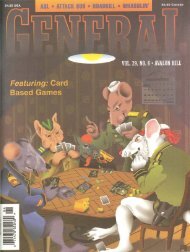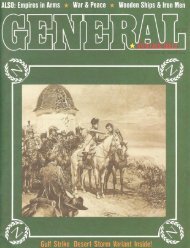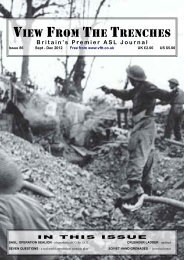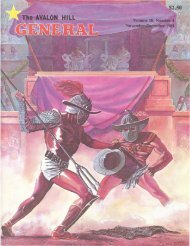18.64MB - View From The Trenches
18.64MB - View From The Trenches
18.64MB - View From The Trenches
- TAGS
- trenches
- www.vftt.co.uk
Create successful ePaper yourself
Turn your PDF publications into a flip-book with our unique Google optimized e-Paper software.
enfilade shots into their advancing ranks, causing<br />
much destruction. When the attack finally struck<br />
home, it fell on the British Guards, who stood fast<br />
and, too everyone's amazement but their own,<br />
hurled the vaunted French Guard back down the<br />
slopes. In the four stages of the battle correspond-<br />
ing roughly to the game turns of this mini-scenario<br />
(1 1AM through 5PM on the 18th June), Napoleon<br />
had "cold dice". It's up to you to see if you can<br />
improve on his results.<br />
While "Wellington Withdraws" was above all<br />
a scenario revolving around the tactics of movement<br />
and position, this mini-scenario is nothing but a<br />
straightforward, toe-to-toe slugging match. Besides<br />
the insights it provides into the actual battle, it is<br />
an excellent and quick way to explore the my rules<br />
on combat (which are a radical departure from the<br />
original system). To give the French a chance, the<br />
Prussians are left out. Victory conditions are very<br />
simple. To win, a player must occupy two of three<br />
hexes at the end of the 5PM turn-Mont Saint Jean,<br />
Braine la Leude, and the village of Waterloo itself.<br />
Thus, the burden of attack rests squarely with the<br />
French player, and Wellington must conduct the<br />
defense he had planned the morning before.<br />
NEW RULES FOR AN OLD FRIEND<br />
With all the above possibilities for play, the new<br />
rules already mentioned become the next order of<br />
business. Gone are the one or two "Optional Rules"<br />
put forward as piecemeal revisions in my earlier<br />
articles. <strong>The</strong> inevitable conclusion finally was<br />
reached. A wholesale rewrite was needed. <strong>The</strong><br />
decision to resolutely rework the whole business has<br />
ended with a new version of rules for the original<br />
board and counters (the idea of revising counters,<br />
mentioned in "Crossing the Sambre" has been<br />
abandoned) which I call the Scenario Edidon of the<br />
WATERLOO rules. This edition is meant to replace<br />
earlier revisions suggested in two other articles and<br />
to be used in playing all three of the scenarios out-<br />
lined in this series of articles.<br />
Though these rules actually are no more com-<br />
plicated than the original rules, their use produces<br />
a drastic change in the play of the game. Some ex-<br />
planation and illustration is vital in coming to terms<br />
with them. In the following sections, separate con-<br />
sideration will be given to unit counters, to stack-<br />
ing, to facing, to terrain effects on movement, to<br />
morale, to a new combat results table, and to com-<br />
bat result modifiers.<br />
1. Unit Counters<br />
Unit types are more completely identified in this<br />
version of the rules. <strong>The</strong> basic distinctions between<br />
infantry, cavalry, headquarters, horse and foot<br />
artillery are preserved unchanged. In addition, units<br />
are now classed as Guards, Regular Line and Land-<br />
wehr (militia). <strong>The</strong> "Landwehr" designation will<br />
be used in these rules rather than "militia" since<br />
the majority of those units are found in the Prussian<br />
army.<br />
French Guards include all units in the Imperial<br />
Guards Corps (only infantry and cavalry units count<br />
as "Guards" for modifying combat, but all so desig-<br />
nated are "Guards" for morale checks). <strong>The</strong> French<br />
have no militia units; all others are considered<br />
Regular Line. <strong>The</strong> British Guards include Cooke<br />
(infantry), Sandham (artillery) and Somerset<br />
(cavalry). <strong>The</strong> only Landwehr in Wellington's army<br />
are the three Hanoverian brigades: Bennigsen,<br />
Bodecken and Beaulieu. On the other hand, the<br />
Prussian army has no Guard units. <strong>The</strong> Prussian<br />
Landwehr units number Luck and Stulpnagel (in-<br />
fantry), and Lutzow, Lottum, Sohr, Schwerin and<br />
Watzdorf (cavalry). Militia regiments also were<br />
mixed in with regulars in several British divisions,<br />
to "fortify" the militia and place them under close<br />
control of regular commanders. Instead of labeling<br />
the whole division as Landwehr in such cases, basic<br />
morale was lowered one point in these. As in WAR<br />
b<br />
COMBAT RESULTS TABLE<br />
Roll two dice. Apply all appropriate combat modifiers. Cross-referencing the combat value odds<br />
(shown attackerfdefender) with the modified die roll, find the result of the combat, shown as<br />
AttackerIDefender (AID). Apply these results to each participant in the combat.<br />
ODDS DICE ROLL<br />
1-6<br />
1-5<br />
1-4<br />
1-3<br />
1-2<br />
2-3<br />
1-1<br />
3-2<br />
2-1<br />
3-1<br />
4-1<br />
5-1<br />
6- 1<br />
7-1<br />
8- 1<br />
Results:<br />
C =Contact (No Effect)<br />
S =Shaken (Check Morale)<br />
W =Withdraw (one hex)<br />
R =Retreat (Withdraw two hexes and Check Morale)<br />
B =Break (Withdraw two hexes and Fail Morale)<br />
Note: Results of modification to the die roll may never result in a die roll greater than "12" nor less than "2". Odds less<br />
than 1-6 result automatically in a "B" for the attacker. Odds greater than 8-1 result produce overrun elimination of the defender<br />
durlng movement. Pay one extra movement point from each unit attacking and simply remove the defenders; movement may<br />
be cont~nued.<br />
& PEACE, all the different unit types are treated<br />
differently in both combat and morale situations.<br />
<strong>The</strong>se changes restore a key aspect of the real<br />
campaign to the game, and also resolve the often-<br />
cited problem of "under-valued" combat factors for<br />
the Guards. Now a combat point simply represents<br />
about a thousand men or a battery of cannon. Unit<br />
type differences now appear as modifiers to the dice<br />
roll in combat resolution and morale checks, instead<br />
of in the combat factor on a particular factor. Guards<br />
units cited should be indentified with a small "G"<br />
placed on the counter; Landwehr should be marked<br />
with an "L". This facilitates identification greatly.<br />
2. Stacking<br />
Under the old rules, you always knew what you<br />
were going to find in a stack. Fifteen strength points!<br />
Unit types made no difference. <strong>The</strong> number of com-<br />
mands required to operate together in a confined<br />
space made no difference. A dozen infantry divi-<br />
sions, totalling perhaps sixty thousand men, often<br />
could be found brawling over the Quatre Bras<br />
heights or some other battlefield on a front of barely<br />
three or four hexes, with no apparent crowding or<br />
untidiness.<br />
This is absurd. In fact, Reille's I1 Corps had only<br />
three of its four divisions engaged there on the 16th,<br />
with some support from artillery and Kellerman's<br />
cavalry; they stretched across this whole front and<br />
filled the very air with violence the whole way.<br />
<strong>The</strong>se new rules (based on stacking unit types rather<br />
than combat factors) do much to take advantage of<br />
all the information Avalon Hill has provided on the<br />
counters and to increase the realism in the way<br />
forces are combined , deployed and used. Based on<br />
those "X"s and "1"s above the unit type designation,<br />
my rules essentially limit players to having two<br />
infantry Xs, two cavalry Xs and two artillery Is per<br />
hex. <strong>The</strong> largest possible Anglo-Allied stack would<br />
then total 14 factors (e.g., Picton, Estorff, Ponsonby<br />
and the Cav Batteries). <strong>The</strong> largest possible Prussian<br />
stack would have 18 combat strength points (Steinmetz,<br />
the I Corps artillery, and Thumen and Sohr<br />
for cavalry). <strong>The</strong> best possible French stack would<br />
total 17 factors (Friant, the Guards artillery and<br />
Guyot). However, these maximums only will be<br />
found in a few stacks. Most will be decidely smaller.<br />
Besides bringing a wonderful dose of realism to<br />
resulting formations, these rules mean the only way<br />
to "pack more punch" into a given space on the<br />
line is through combined arms tactics, on which<br />
Napoleon based a great measure of his own success.<br />
To help reflect this, one set of combat modi-



